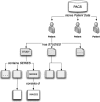Sharing data and analytical resources securely in a biomedical research Grid environment
- PMID: 18308979
- PMCID: PMC2409996
- DOI: 10.1197/jamia.M2662
Sharing data and analytical resources securely in a biomedical research Grid environment
Abstract
Objectives: To develop a security infrastructure to support controlled and secure access to data and analytical resources in a biomedical research Grid environment, while facilitating resource sharing among collaborators.
Design: A Grid security infrastructure, called Grid Authentication and Authorization with Reliably Distributed Services (GAARDS), is developed as a key architecture component of the NCI-funded cancer Biomedical Informatics Grid (caBIG). The GAARDS is designed to support in a distributed environment 1) efficient provisioning and federation of user identities and credentials; 2) group-based access control support with which resource providers can enforce policies based on community accepted groups and local groups; and 3) management of a trust fabric so that policies can be enforced based on required levels of assurance.
Measurements: GAARDS is implemented as a suite of Grid services and administrative tools. It provides three core services: Dorian for management and federation of user identities, Grid Trust Service for maintaining and provisioning a federated trust fabric within the Grid environment, and Grid Grouper for enforcing authorization policies based on both local and Grid-level groups.
Results: The GAARDS infrastructure is available as a stand-alone system and as a component of the caGrid infrastructure. More information about GAARDS can be accessed at http://www.cagrid.org.
Conclusions: GAARDS provides a comprehensive system to address the security challenges associated with environments in which resources may be located at different sites, requests to access the resources may cross institutional boundaries, and user credentials are created, managed, revoked dynamically in a de-centralized manner.
Figures





Similar articles
-
The Cancer Biomedical Informatics Grid (caBIG) Security Infrastructure.AMIA Annu Symp Proc. 2007 Oct 11;2007:433-7. AMIA Annu Symp Proc. 2007. PMID: 18693873 Free PMC article.
-
caGrid 1.0: an enterprise Grid infrastructure for biomedical research.J Am Med Inform Assoc. 2008 Mar-Apr;15(2):138-49. doi: 10.1197/jamia.M2522. Epub 2007 Dec 20. J Am Med Inform Assoc. 2008. PMID: 18096909 Free PMC article.
-
Security and privacy requirements for a multi-institutional cancer research data grid: an interview-based study.BMC Med Inform Decis Mak. 2009 Jun 15;9:31. doi: 10.1186/1472-6947-9-31. BMC Med Inform Decis Mak. 2009. PMID: 19527521 Free PMC article.
-
[caCORE: core architecture of bioinformation on cancer research in America].Beijing Da Xue Xue Bao Yi Xue Ban. 2006 Apr 18;38(2):218-21. Beijing Da Xue Xue Bao Yi Xue Ban. 2006. PMID: 16617371 Review. Chinese.
-
An infrastructure for interconnecting research institutions.Drug Discov Today. 2009 Jun;14(11-12):605-10. doi: 10.1016/j.drudis.2009.03.011. Epub 2009 Apr 1. Drug Discov Today. 2009. PMID: 19508923 Free PMC article. Review.
Cited by
-
Semantic web data warehousing for caGrid.BMC Bioinformatics. 2009 Oct 1;10 Suppl 10(Suppl 10):S2. doi: 10.1186/1471-2105-10-S10-S2. BMC Bioinformatics. 2009. PMID: 19796399 Free PMC article.
-
caGrid-Enabled caBIG Silver Level Compatible Head and Neck Cancer Tissue Database System.Open Med Inform J. 2010 Sep 1;4:171-8. doi: 10.2174/1874431101004010171. Open Med Inform J. 2010. PMID: 21589853 Free PMC article.
-
HPC AND GRID COMPUTING FOR INTEGRATIVE BIOMEDICAL RESEARCH.Int J High Perform Comput Appl. 2009 Aug 1;23(3):252. doi: 10.1177/1094342009106192. Int J High Perform Comput Appl. 2009. PMID: 20107625 Free PMC article.
-
Adoption and Adaptation of caGrid for CTSA.Summit Transl Bioinform. 2009 Mar 1;2009:44-8. Summit Transl Bioinform. 2009. PMID: 21347169 Free PMC article.
-
Identifiability in biobanks: models, measures, and mitigation strategies.Hum Genet. 2011 Sep;130(3):383-92. doi: 10.1007/s00439-011-1042-5. Epub 2011 Jul 8. Hum Genet. 2011. PMID: 21739176 Free PMC article. Review.
References
-
- Saltz J, Oster S, Hastings S, Langella S, Kurc T, Sanchez W, et al. caGrid: Design and Implementation of the Core Architecture of the Cancer Biomedical Informatics Grid Bioinform 2006;22(15):1910-1916. - PubMed
-
- Czajkowski K, Ferguson DF, Foster I, Frey J, Graham S, Sedukhin I, et al. The WS-Resource Framework version 1.0. 2004[cited 2004]http://www.globus.org/wsrf/specs/ws-wsrf.pdf 2007. Accessed March 2008.
-
- Foster I, Czajkowski K, Ferguson DF, Frey J, Graham S, Maguire T. Modeling and Managing State in Distributed Systems: The Role of OGSI and WSRF Proceedings of IEEE 2005;93(3):604-612.
Publication types
MeSH terms
Grants and funding
LinkOut - more resources
Full Text Sources

